2 Oct 2017
John Chitty explains the basics of handling rabbits during an examination and how practices can be more accommodating.

Rabbits are nothing like cats and dogs – they are prey species and, as such, find anything outside their normal secure environment stressful. A trip to the vet most certainly falls into this category.
So, are vets ready for them? Given that rabbits are commonly kept and often brought in by very bonded and informed owners, it is surprising how unprepared we often are, especially as most of what is needed is simple, inexpensive and more a state of thinking than material expense.
Veterinary practices keen on rabbits are recommended to join the Rabbit Welfare Association and Fund rabbit friendly practice scheme.
Less “bricks and mortar” and more about how the practice thinks about rabbits, this scheme provides a good framework for reducing the stress of a veterinary visit for any rabbit.
This article features a selection of ideas from the author’s practice.
One of the best things about setting up for a rabbit consult is the very little need for major financial investment – most can be done with the same basic equipment as you would use for a cat consult:
It is also a good idea to have some towels to hand, for laying on smooth surfaces/scales and to wrap where necessary (Figures 1 and 2).

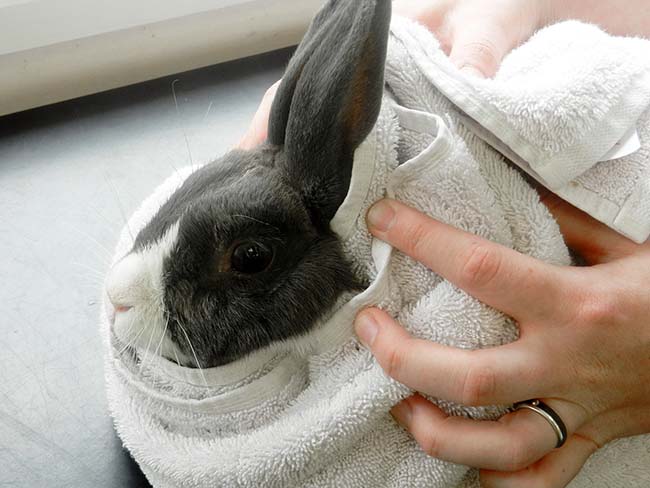
As an investment, access to a capnograph is really helpful as it is an excellent means of assessing respiratory function in the conscious rabbit.
Although rabbits are nothing like cats, their waiting requirements are very similar:
As ever, rabbit owners should always be encouraged to bring in any rabbit companions, as company will greatly reduce the stress of the journey and being in the waiting area.
It is impossible to be good at everything and, while we do need to know the basics of dealing with each species, staff in the clinic need to know who is good with rabbits and who really wants to concentrate on them instead of dogs and cats. That enables the reception to book patients with the right vet.
This is fine during routine hours and while that vet is in the building. However, there does need to be some replication of that expertise when the “rabbit vet” is away or off duty, or he or she may need to be working 24/7. Similarly, out-of-hours needs covering, too – it is great to build up expertise and a considerable reputation, but when an OOH emergency happens (and with rabbits they are not rare) you need your OOH provider to deliver a similar level of expertise or the reputation will soon disappear. In other words, share knowledge and make sure the clinic is not solely reliant on one person.
Nurses, too, are important – rabbits often need intensive nursing care and their anaesthesia can be challenging. Well-trained and committed nurses massively enhance the clinic’s ability to see and treat rabbits.
Most of the drugs you will need to use will be unlicensed in rabbits. Some licensed drugs are available, so knowledge of the cascade and how it works is essential. Consider client communication – blanket permissions for unlicensed drugs or separate permissions for every single drug are fine, but do not remove the need to inform the client of potential side effects. This includes licensed drugs, too.
The clinic will be judged on the quality of rabbit information it provides. Many sources of good information are available, so clients can be signposted to reputable websites, or the clinic can write its own handouts and educational materials.
Social media plays a big role. Rabbit clients are often very internet-savvy – you need to be up to date with current knowledge, especially the occurrence rate and location of infectious diseases.
The author likes using a small compact room. As well as making it easier to recapture escaped birds and sugar gliders, it also makes it a less open and threatening environment for prey species. It also means all the equipment you need is within easy reach of the centre of the room. That said, there must be sufficient space where the equipment can be stored, and that allows examination on a table and on the floor to be done. A wall-mounted folding table is a great boon.
In positioning the room, it should be quiet and away from the noisier species seen in the practice. If possible, it should not be used for dogs and, preferably, cats or ferrets. Rabbits are sensitive to the smell of these species and, if the room is shared, try to schedule rabbits earlier or air the room between species.
It is easy to get rabbit handling wrong, and with “weak” bones and spines the consequences can be severe. Excellent handling advice is provided by the Veterinary Defence Society.
If in doubt, do not lift rabbits too far or at all. Most come in plastic carry boxes, which can be dismantled, leaving the rabbit sat in the base surrounded by low “walls”. Leave the door in place with the rabbit facing this and it will tend to sit still during a basic examination (Figure 3).
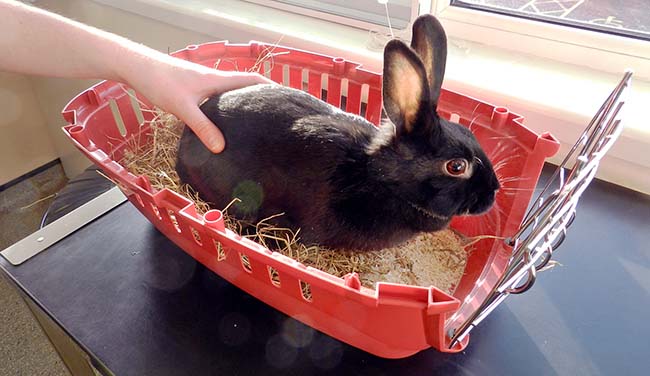
As mentioned, stressed rabbits will often do better being handled on the floor. This may reduce the chances of the rabbit becoming upset and also reduce the chances of severe injury if an upset rabbit were to start jumping around.
When rabbits are lifted, always support the hindquarters and spine – this will minimise the risk of self-induced injury. To support the forequarters a hand may be placed under the thorax or the rabbit may be scruffed (Figure 4). The latter is more secure, but is not liked by some owners, and some rabbits (like cats) do not appreciate full restraint. If in doubt, ask permission before scruffing, and if the rabbit becomes stressed, stop.
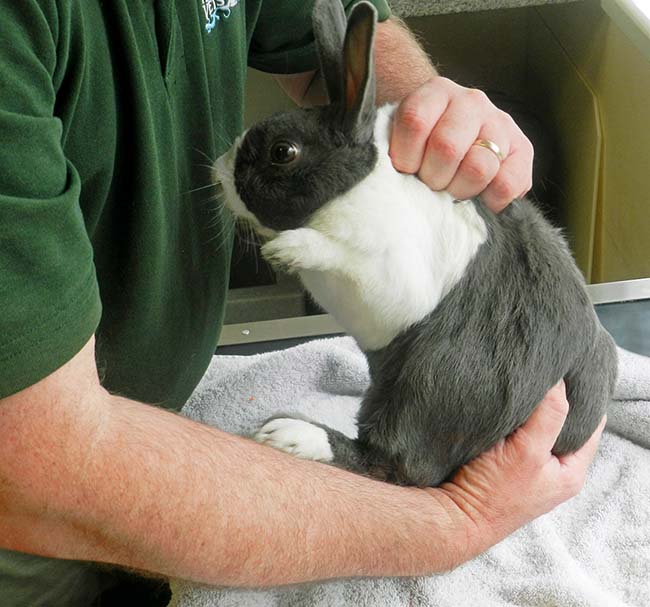
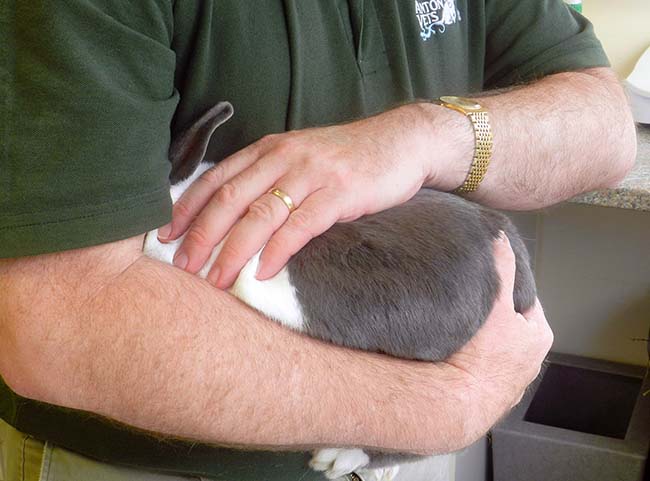
Some examinations and techniques (such as nail clipping) are greatly facilitated by turning the rabbit upside-down. However, this is a highly controversial technique in that it induces a tonic immobility response more normally associated with a fearful state (Figure 5). Some feel for very short-term procedures it may be less stressful than restraint in ventral recumbency. In any case, if performed, permission must be gained from the owner before restraining a rabbit in this manner. And, if done, the rabbit must be returned to ventral recumbency as quickly as possible.
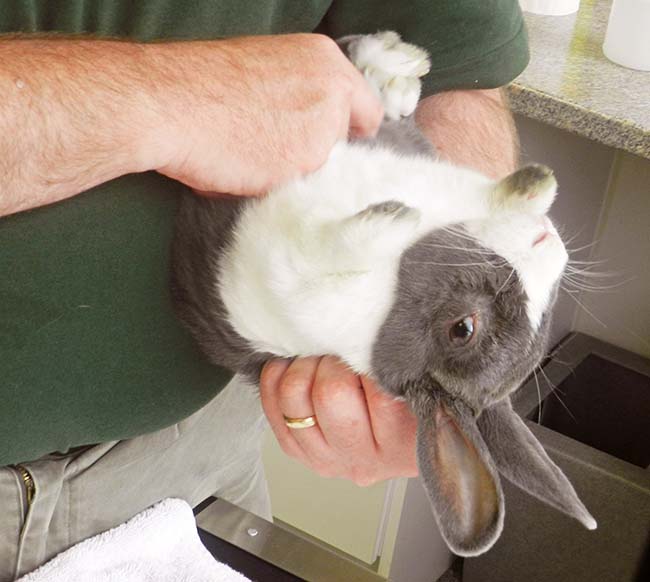
A clinical examination is essentially the same in all species; however, the following points may be relevant to rabbits:
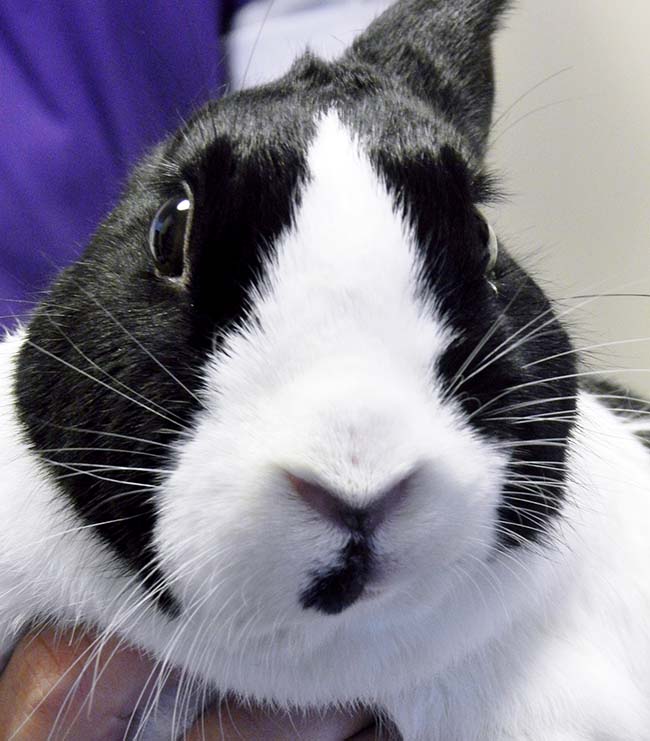
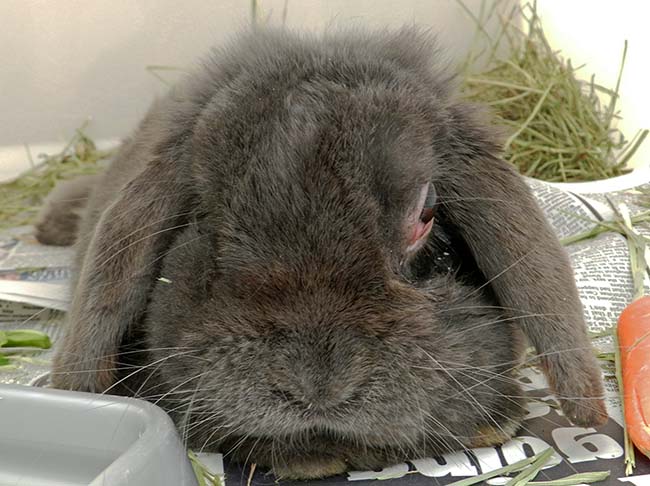

This is by no means a complete guide to rabbit consultations, but a selection of tips from the author’s practice and experiences. The main issue for practices seeing these species is to recognise their unique features and adapt “normal” working practices to their needs.